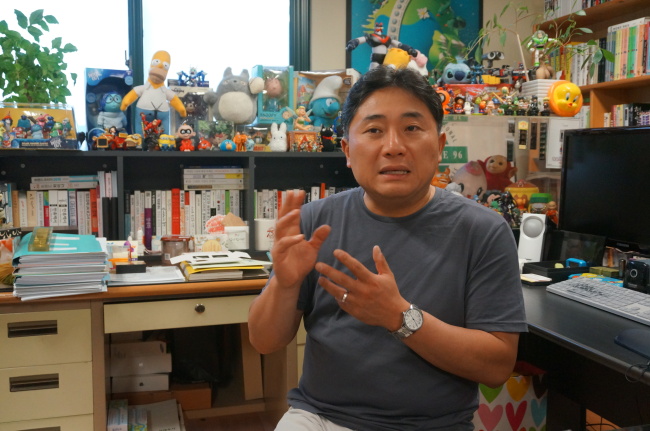'Innovative platforms can turn tide for Korean animations'
Smart devices, multi-channels expected to improve animation ecosystem
By 박형기Published : Sept. 4, 2015 - 17:25
The Korean animation industry poses a mixed picture. Despite the popularity of children’s animations with such hits as “Pororo,” “Robocar Poli” and “Tayo” in the local and global market, many local animation studios still suffer losses.
They are trapped in a vicious cycle. Animation studios face mounting losses as they continue to create sequels to their series. Securing a spot on TV doesn’t solve the problem. The fees they receive airing their series on TV doesn’t even cover half the production costs.
They are trapped in a vicious cycle. Animation studios face mounting losses as they continue to create sequels to their series. Securing a spot on TV doesn’t solve the problem. The fees they receive airing their series on TV doesn’t even cover half the production costs.

“It would sound unrealistic if Korean animation studios make profits from screening their animations at movie theaters and on TV,” said Han Chang-wan, president of the Animation Society of Korea, in an interview last week. Han is professor of the department of cartoon animation at Sejong University.
“In this industry, money doesn’t flow to animators,” he added.
Animation studios receive about 10 million to 15 million won ($8,145-$12,624) for airing their series on TV while they invest at least more than 50 million won in production. The gap leaves animation studios with losses as they continue to make next episodes.
Even if animators license manufacturers to produce characters, they often fail to manage and control character licensing and production with a small number of staff.
“Pororo and Larva have been lucky cases in Korea. But most of the animations don’t last long,” said Han.
Meanwhile, the size of two-dimensional cartoon has grown rapidly thanks to the popularity of webtoon, or online cartoon series. The size of webtoon market has surpassed some 172 billion won last year, according to the Ministry of Culture, Sports and Tourism. It attracted broader audience from teenagers to older viewers thanks to its diversity in genres and mobility.
Although animations seem to lose ground, Korean animators found niche audiences to survive in the competition with Japanese animation along with Disney and Pixar animated movies. It has reached the younger audience with “Pororo” and to more general audience with short, slapstick, nonverbal animation such as “Larva” that air on screens in public transportations and shopping malls.
“Pororo, the Little Penguin” has led the unprecedented success in Korean animation since it began to air in 2003. It has been sold to more than 100 countries, including Brazil recently. Larva, featuring two larvae’s adventures, has reached viewers in 106 countries.
“Animation itself is a cultural content and a piece of art, but the Korean animation industry needs to come up with diverse ways and strategies to generate profits,” he said.
Han said a new online platform may offer a ray of hope.
If animators can cope with the rapidly changing industry using new smart devices and innovative platforms, the animation industry may have a chance to revive.
“It sounds distant as my students are still expecting they would be making long animated movies or TV series in the future. But the industry will not look like what we see today,” he said.
He predicted a new online platform could bring more opportunities to the animation industry.
The new platform he envisions is multi-channel networks built on video sharing websites such as YouTube. Viewers can browse thousands of animations uploaded on the network and watch animations they like. If they like, they can share them with their friend through social networking sites. They can also purchase characters and related products directly on the website.
“Let’s say a bar shows while playing that tells a viewer to download an online file that you can use to print out your favorite character in three-dimensional form using a 3-D printer for just $5,” he said.
He predicted that the development of 3-D printing technology will accelerate the advent of this new platform.
It will also boost the Korean animation market and make local animations approachable to a broader audience.
He saw how Korean parents uses smart devices to show their kids “Pororo” and said it may give an answer to whether the new platform will be successful or not.
Children no longer sit and wait to watch their favorite animations in front of TV. Parents download episodes from the Internet Protocol Television, or have their kids watch them on smartphones or tablet PCs.
“Sometimes parents use animations to calm their kids in public places such as restaurants and shopping malls. I think this applies to every parent in the world. If smart devices have proven to be an effective platform for animations in Korea, so would it be in other countries too,” he said.
By Lee Woo-young (wylee@heraldcorp.com)




![[Herald Interview] 'Amid aging population, Korea to invite more young professionals from overseas'](http://res.heraldm.com/phpwas/restmb_idxmake.php?idx=644&simg=/content/image/2024/04/24/20240424050844_0.jpg&u=20240424200058)












![[KH Explains] Korean shipbuilding stocks rally: Real growth or bubble?](http://res.heraldm.com/phpwas/restmb_idxmake.php?idx=652&simg=/content/image/2024/04/25/20240425050656_0.jpg&u=)

